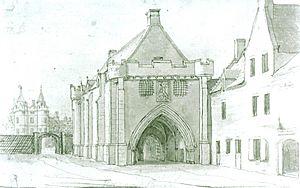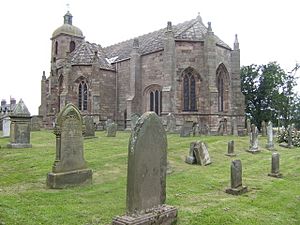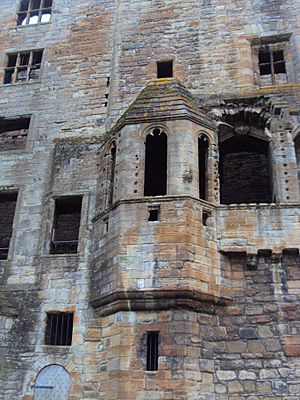Thomas Peebles (glazier) facts for kids
Thomas Peebles, also known as Peblis, was a skilled Scottish glazier. A glazier is someone who works with glass, especially making and fitting windows. Thomas Peebles worked for three Scottish monarchs: King James IV, his wife Queen Margaret Tudor, and their son King James V.
In old Scotland, a glazier was called a "glassin wright." These craftspeople often joined groups called "incorporations" with other builders and artists. Glaziers were often grouped with painters. Thomas Peebles had his workshop in a large building at Holyrood Palace, which was one of the king's main homes. He received a yearly payment from the royal treasury to keep the windows of all the royal palaces in good condition. He also got paid for any new work he did and even received special clothes from the king.

Contents
What Did Thomas Peebles Do?
Thomas Peebles made windows using panes of glass, often imported from other countries. He joined these glass pieces together with lead strips called "cames." He traveled to different royal homes to measure and install windows. The Scottish court moved around a lot, but the windows usually stayed in place, unlike tapestries which were often moved.
Windows for Royal Palaces
In 1504, Peebles measured windows for the church at Ladykirk. He then brought glass to the church and installed it in 1507. In 1511, he made windows for the "Palace of Stirling," which is likely the old royal building still standing today, known as the King's Old Building.
In April 1512, Peebles helped prepare Linlithgow Palace for Easter. He fixed some windows with strong cloth from France and also supplied special "glassbands" and clamps for other windows. He even replaced the glass in the Great Hall. This work was probably done because Queen Margaret Tudor was staying at the palace, and her son, James V, was born there on April 10th.
Later in 1512, he glazed Queen Margaret's private prayer room, called an "oratory," at Holyroodhouse. He used "painted rounds with chaplets," which were decorative glass pieces. In 1513, he replaced the glass in the queen's oratory at Linlithgow Palace. This was likely a special window that looked out over Linlithgow loch.
In 1532, Peebles supplied glass for a new tower at Holyroodhouse. Important rooms had fancy windows with "painted work," round and square pieces, and designs that included the King's coat of arms. Some of these round glass pieces, possibly from Flanders, were brought in by a merchant named William Anderson.
At Linlithgow Palace in 1535, he provided glass for the chapel and the Great Hall. The Great Hall was also called the "Lion Chamber." The five chapel windows had "five images" of "painted work" along with clear "white glass." Peebles received an advance payment of 20 Scots pounds for more work. The records show that painted glass was more expensive than clear glass.
Later Work and Retirement
In 1537, Thomas Peebles received another payment from the king. This was for giving up his workshop at Holyrood Palace. His workshop was in the upper part of the abbey gatehouse. This building, built in 1502, can still be seen today. The space was then used to repair the royal tapestries.
In 1540, he made many windows for Falkland Palace. This included windows for the north wardrobe, the bakery, the porter's lodge, the new chapel, and other areas. He often reused old glass and set it in new lead frames. At Holyrood, he took old windows from the gatehouse and remade them for the Great Hall.
After King James V died, Peebles continued to work for the queen, Mary of Guise. In 1543, he repaired windows at the royal palaces of Stirling and Falkland for her.
Thomas Peebles' wife helped the royal works by providing food for the cart horses. We do not know her name or when Thomas Peebles died.
Heraldic Glass in Scotland

Heraldic glass means stained glass that shows coats of arms or symbols of important families. It was used to decorate homes and castles in Scotland during the 1500s.
In January 1540, another glazier named Robert Binning installed glass at David's Tower and the chapel in Edinburgh Castle. In August 1550, Walter Binning, who was both a painter and a glazier, supplied glass for Hamilton Palace. This glass was "kelyeit," meaning it had the coat of arms of Regent Arran, a powerful Scottish leader, marked on it. It's not clear if Binning painted these arms himself or if the glass was imported with the designs already on it.
A poem from 1549, called The Complaynt of Scotland, mentions heraldry being used on seals, rings, painted on walls, and "in your glasyn windowis" (in your glass windows). A great example of this kind of glass can still be seen at the Magdalen Chapel in Edinburgh. A window there shows the symbols of Mary of Guise and the chapel's founders, Michael MacQueen and his wife Jonet Rhynd.
Even earlier, in the 1430s, an Italian stained glass artist named Francesco Livi traveled to Scotland to work for King James I. He might have worked at the Perth Charterhouse, a monastery in Perth.



